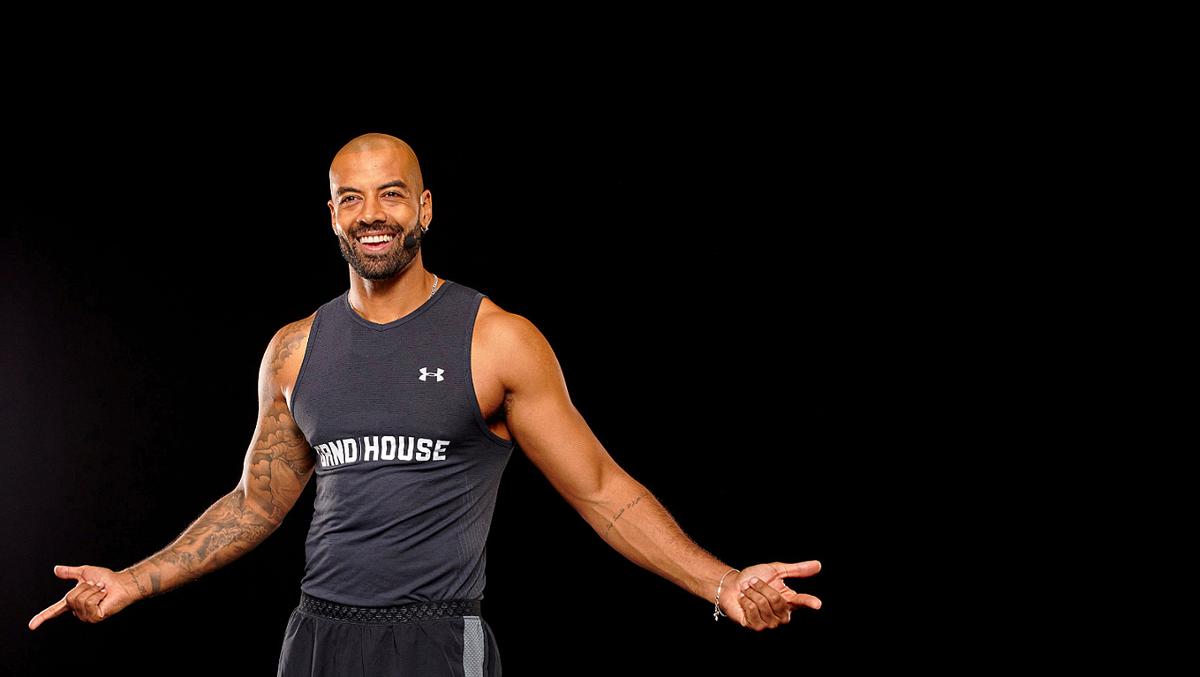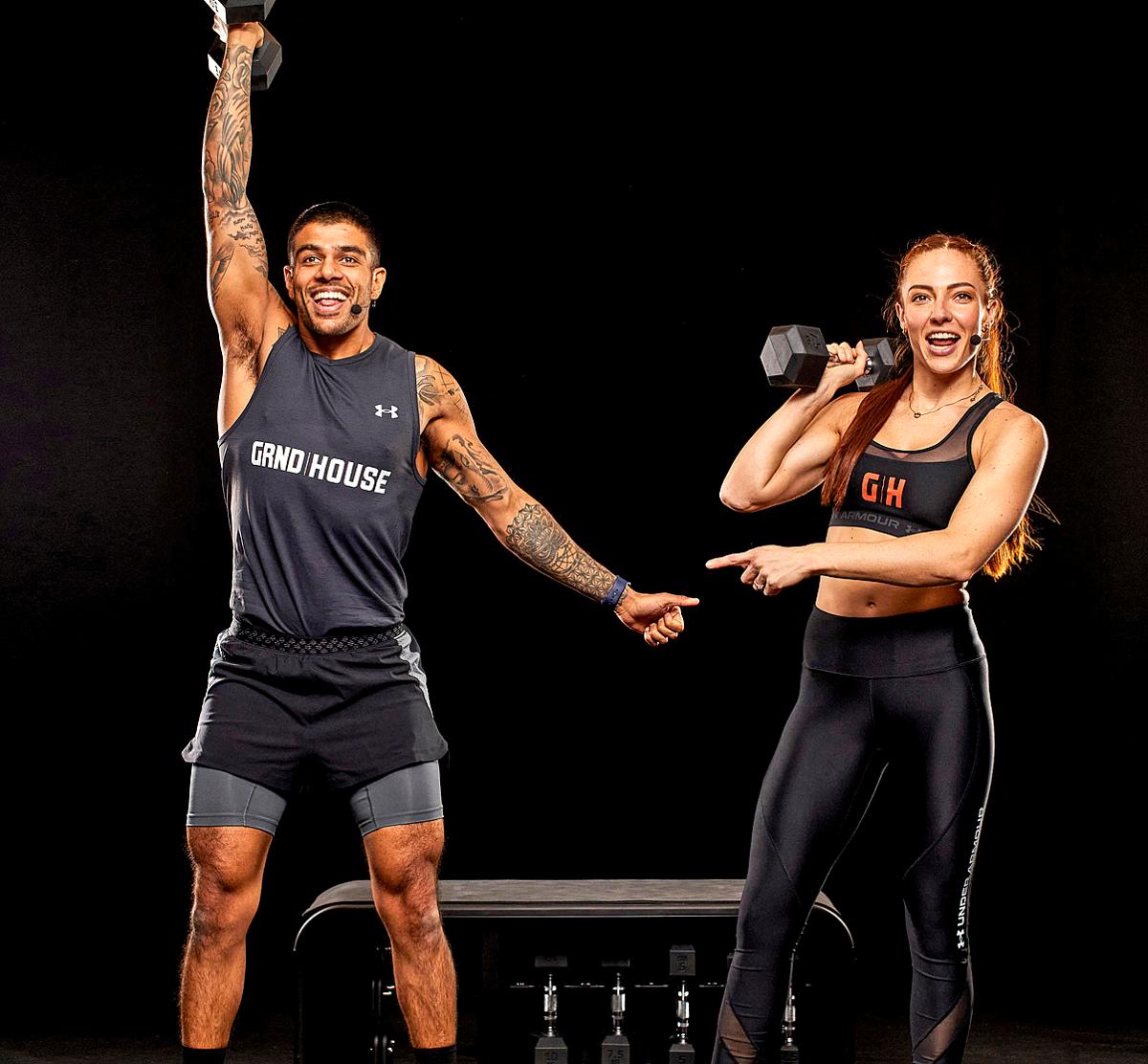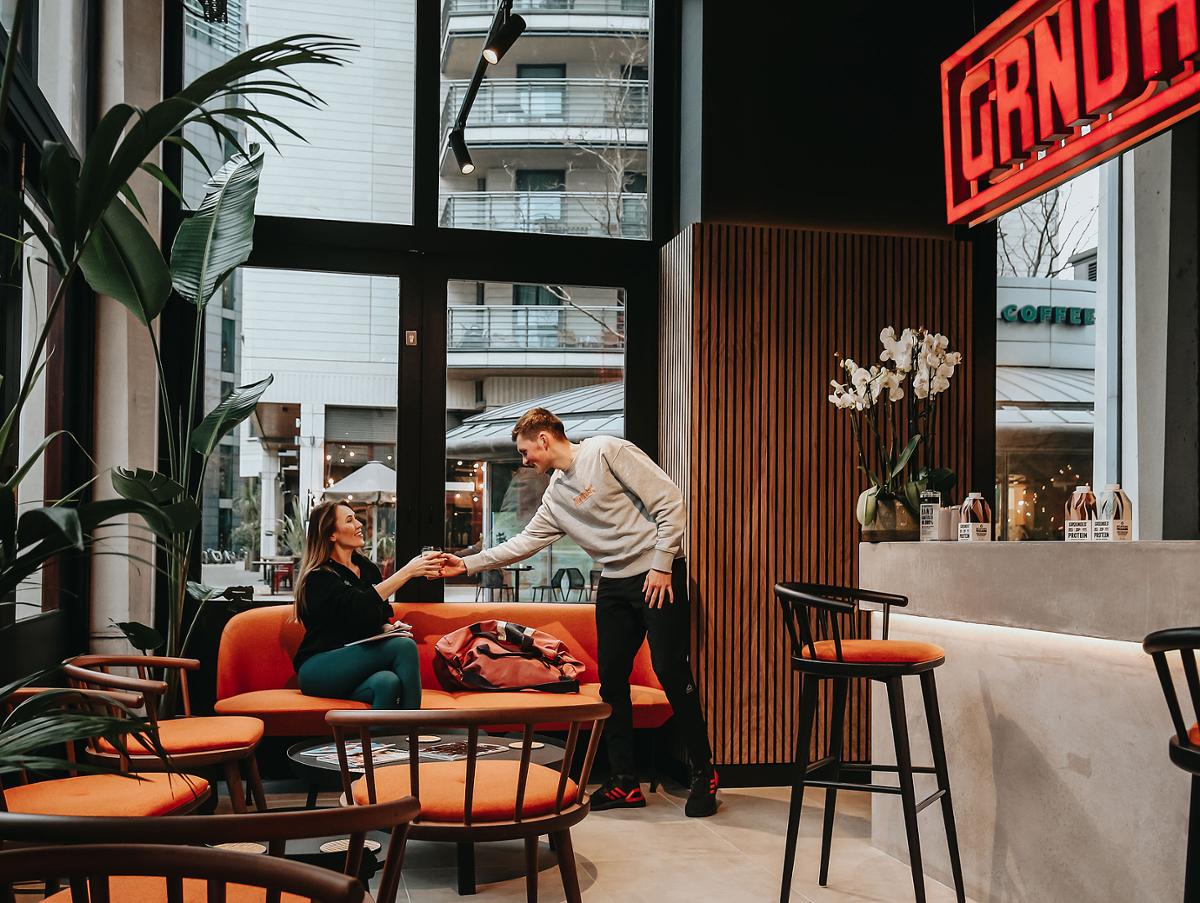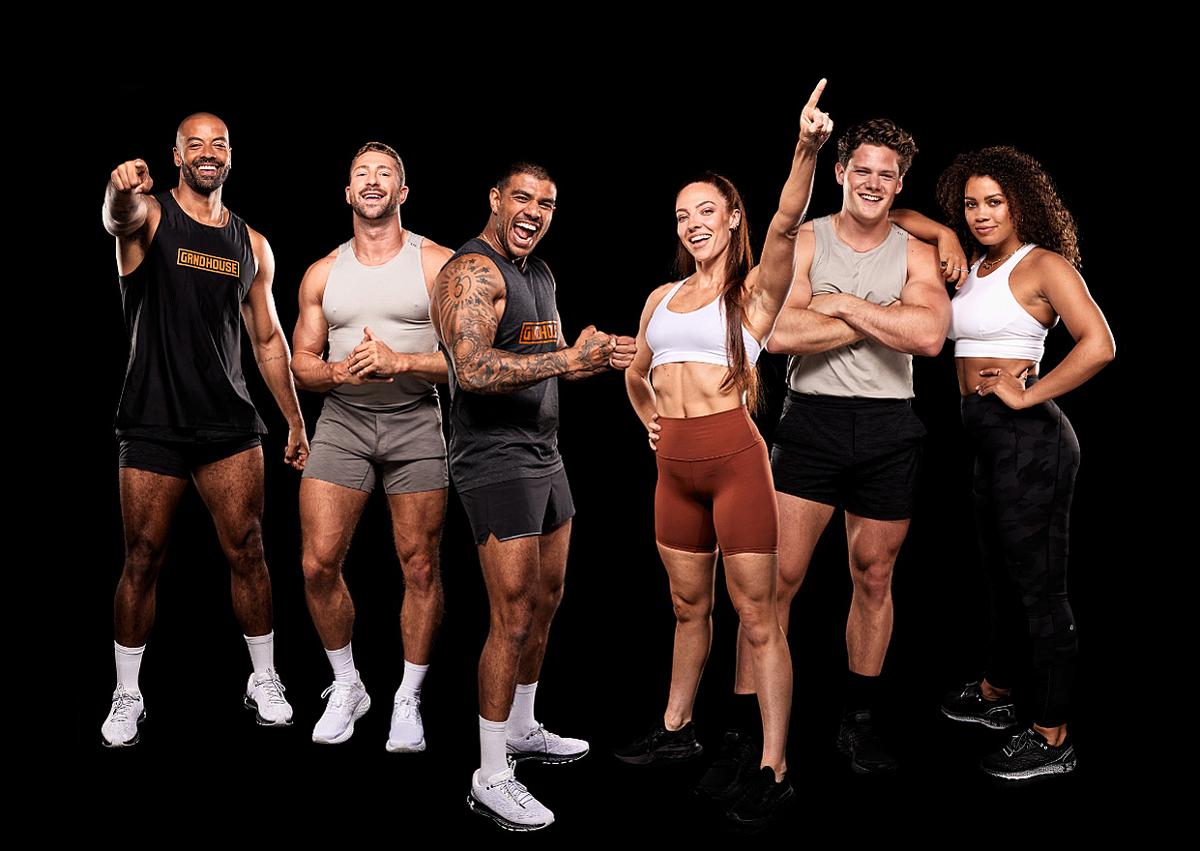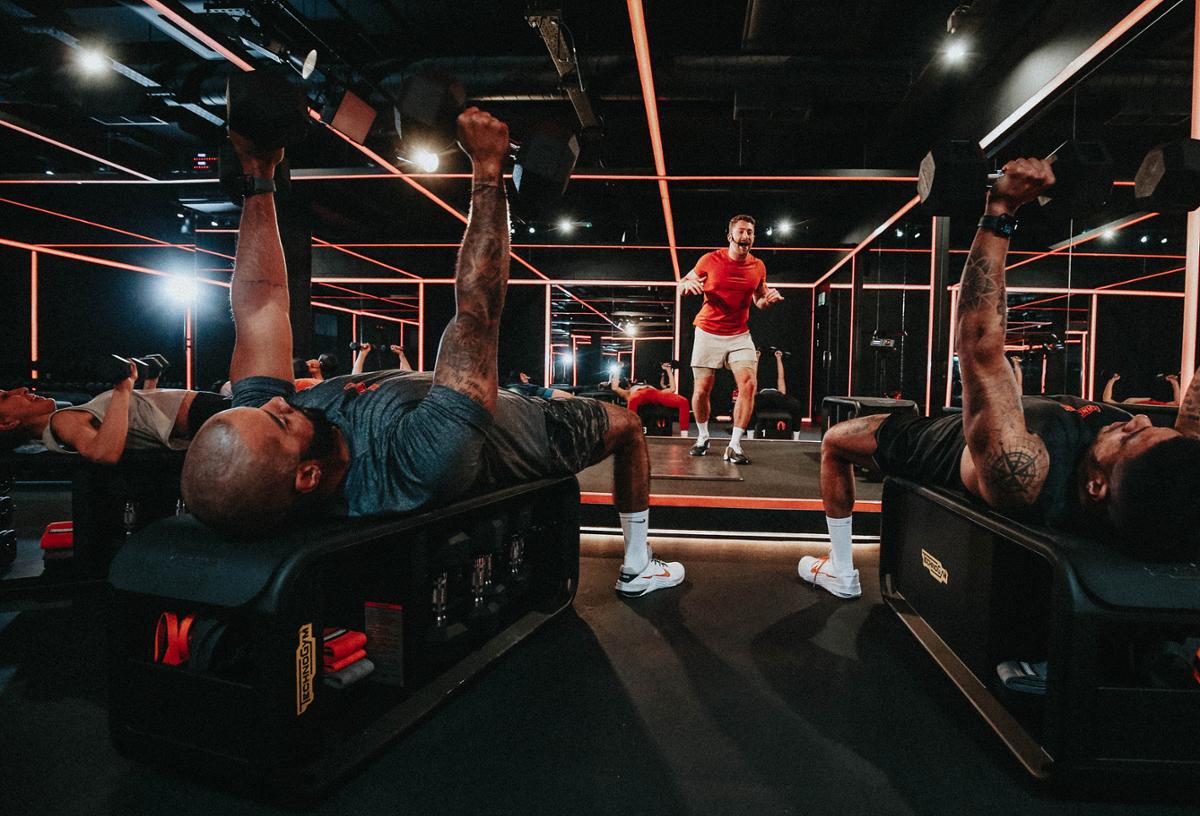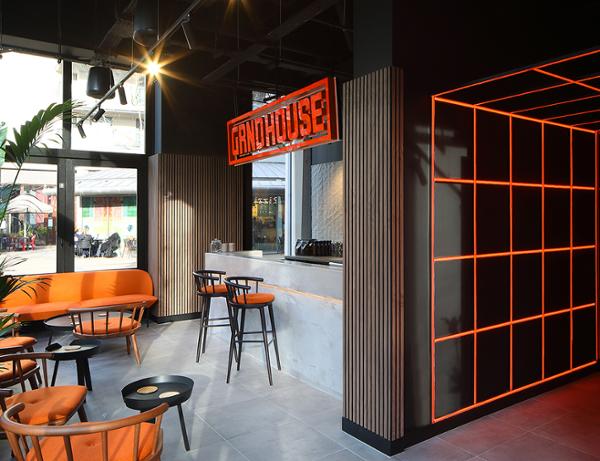You started off with a digital platform and then launched a studio – what’s the story?
We were five best friends (me, Jay Copley, Connor Minney, Nik Naidoo and Izy George) who helped take Barry’s in the UK from one studio to, I think it was eight, by the time that we left. The pandemic came so we lost our income and started doing online classes on our own individual platforms – just like every other trainer at the time.
We were doing strength training though, which really took off for each one of us. We looked at the market, saw that no one was owning the online strength training lane, which is what we’ve been doing all our careers, and decided to create Grndhouse.
Where did the name come from?
Grndhouse came from “the grind in our house” and there’s no “i” in GRND because we’re a team.
What happened next?
We put all our existing productions into one place to build the business and launched a web-based prototype platform in January 2021. We got one thousand subscribers within the first month, which was a surprise, because our target had been 250. We made back the money we’d invested within the first hour. Business was going so well that we decided to seek investment.
What funding did you raise?
In November 2021 we secured a £1.5m investment for the launch of a fitness studio and app. Passion Capital was our lead investor, there were several angel investors, and the rest was Seedrs crowdfunding. We spent £1m in a couple of months and one year later we opened our studio in Paddington, which allows our online clients to come down and get the in-person experience too.
What was your vision for the Grndhouse studio in Paddington?
We wanted it to be a cool place to hang out, somewhere you didn’t have to bring a hairdryer or shampoo, but have a workout in a home from home. We wanted the workouts to be like a show. You can chill out in ‘the calm before the storm’, then go into the studio and the lights change – we wanted to create a different experience.
You hired Zynk as designer, tell us more about the look of the space.
We went for burnt orange because we felt this colour was universal, it wasn’t masculine or feminine. We didn’t do a deep dive into branding, it came about naturally. The light tunnel creates a good Instagram moment. You can take a picture and show the world where you are.
How is Grndhouse different?
We found that with most online fitness content there isn’t any direction on where to start. To create some unity, we created a weekly structure running from Monday to Sunday. We offer 500 workouts going from lower body, to core and abs and upper body. It is total body conditioning that has high-impact and low-impact days. Strength training is so much bigger than these workouts, though. Our app will provide different types of strength training to help people achieve their fitness goals in other activities.
Why did you decide to focus on strength training?
We all have a passion for strength training, so it was natural for us to gravitate towards it. There’s always been a stigma around strength training, where you have to be male and lift super heavy. The strength training we’re creating is different. It is high intensity, uses weights and is not your typical Olympic lifting. We’re changing the meaning of strength training and what it means to the consumer.
How do you get over some women’s fear of becoming too muscular?
It’s just educational. The average amount of muscle a woman will put on if she is a professional bodybuilder and lifts six times a week is probably about 2-3lbs a year. Unless they are really pushing the bodybuilding agenda, they will just condition the muscle to be healthier, leaner and stronger.
How many subscribers do you have now?
It’s still in the low thousands, but this is because we switched our marketing off and concentrated on organic growth. We focused on nurturing our current subscribers, finding out what they wanted from the product and then making it into what they need it to be.
How many do you hope to have by the end of 2022?
We’re aiming to have 10,000 subscribers by the end of this year, which we think is possible. We’ve had steady growth and our attrition rate is low. Generally, in this industry, people tend to stick at things for up to six weeks then stop, but our average member stays five to six months, and they complete, on average, two-and-a-half workouts each week. Many fitness companies just concentrate on getting people in, but we’re trying to create a lifestyle change.
Can you tell us more about the app?
We’ve been developing the app for 15-16 months now and we’re almost ready to launch. From there we will build the product up into what Grndhouse will eventually be, which includes personalised strength training with a big community element. I think there is scope to push into mindful training as well. The initial goal is to get our existing users onto it. Phase 2 will be building up the categories, community and metrics. After that we’ll have our big launch.
What strength-training categories will the app offer?
When you open the app, you can choose what strength training you want to do, such as running, pre- and post-natal, post-injury, pre-injury, sports specific categories, like football, swimming, tennis, and so on. It’s key we have an over 60s category too. The first version of our app won’t be AI-assisted, but it will become so as we progress over the next 12-18 months. AI needs numbers and so we must build our community for the machine learning to work.
How will AI drive personalised training?
Over time the app will start to learn what you like and what strength training you want to do – your interface, for example, would look completely different to mine. It will still have the weekly structure, but will recommend workouts according to your body type. You can use a heart rate monitor, too, which will also give you a hustle score, based on the amount of time you’ve spent in different HR zones.
The algorithm will start to learn how to make progress on that score and push harder. It will allow people to strength train and feel the progression as well.
Why is strength training important?
Strength training is overlooked. As we get older our bodies get weaker, so it’s about building the foundations we need as we go through life. Strength training brings many health benefits, such as improved bone density and increased life expectancy, but a big aspect is the mental side. There’s nothing like becoming stronger and feeling more confident. Many people push the cardio to lose weight or get a quick result, but the more muscle mass you have, the faster your metabolism will be, making it easier to lose excess weight. If we lift weights, we burn fat for up to 48 hours, whereas it’s only 12 hours after cardio.
Tell us about the kit
We have 40 Technogym Benches in the new London studio – we love its design, as it makes it easy to film a straight-through workout.
We originally started with it because people were working out at home and we realised it was great size and look for the home and Technogym understood our vision and helped us offer members the bench and hex dumbbells.
Online we’re evolving beyond it because it can create a barrier – people think they might need one to do our workouts, but they don’t. There will still be bench workouts, but 75 per cent of workouts just need dumbbells, 10 per cent require bands and 15 per cent are bodyweight only.
Your Instagram resembles mainstream TV – why is this part of your approach?
We’re a content provider at the end of the day. We want you to be watching Grndhouse for more than just a 45-minute workout, so it’s about creating content that’s interesting and people engage with.
Will you build more studios?
Our flagship store, the Grndhouse HQ, will be the only one. We don’t think the in-person experience is here to stay. Our goal is to make strength training accessible to people outside of London and around the world. Instead of £25 a class you can do a whole month of classes on Grndhouse.
Will you be doing more fundraising?
It’s a case of going bigger. We want to break America, go to American VCs and get more funding. We want to be the leaders in strength training – Peloton and other providers class themselves as an at-home product, but we want Grndhouse to be everywhere: in gyms, hotels, on holidays, at home. It’s boutique fitness in your hand.
How soon will you approach the US market?
We’re thinking about going to the States this summer for our next round of funding.
How profitable is Grndhouse?
We won’t be profitable for a long time as we put all our money back into R&D. What I can say, though, is that we matched last year’s revenue in Q1 this year.








